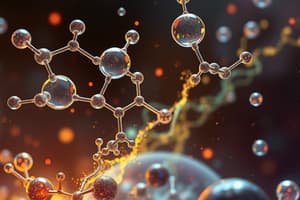Podcast
Questions and Answers
What role do nitrogen lone pairs play in amines?
What role do nitrogen lone pairs play in amines?
- Enhance reactivity by participating in various chemical reactions (correct)
- Have no impact on reactivity
- Prevent chemical reactions
- Decrease reactivity
In which of the following applications are amines NOT commonly used?
In which of the following applications are amines NOT commonly used?
- Construction (correct)
- Drug development
- Environmental applications
- Polymer chemistry
What type of reactions can amines undergo to form new amine compounds?
What type of reactions can amines undergo to form new amine compounds?
- Oxidations
- Acid-catalyzed reactions
- Amination reactions (correct)
- Carbon-carbon bond cleavage
How are amines commonly used in drug discovery and design?
How are amines commonly used in drug discovery and design?
What happens when amines undergo acid-catalyzed reactions?
What happens when amines undergo acid-catalyzed reactions?
What is the significance of understanding the fundamentals of amine chemistry according to the text?
What is the significance of understanding the fundamentals of amine chemistry according to the text?
Which type of amine compound has one nitrogen atom with one alkyl or aryl group bonded to it, and one hydrogen atom?
Which type of amine compound has one nitrogen atom with one alkyl or aryl group bonded to it, and one hydrogen atom?
How many alkyl or aryl groups are bonded to the nitrogen atom in tertiary amines?
How many alkyl or aryl groups are bonded to the nitrogen atom in tertiary amines?
What is the main chemical property of amine compounds that allows them to neutralize acidic compounds?
What is the main chemical property of amine compounds that allows them to neutralize acidic compounds?
Which type of amine compound has one nitrogen atom with four alkyl or aryl groups bonded to it, and no hydrogen atom?
Which type of amine compound has one nitrogen atom with four alkyl or aryl groups bonded to it, and no hydrogen atom?
What term describes the ability of amines to readily react with electrophilic compounds?
What term describes the ability of amines to readily react with electrophilic compounds?
When amines accept a proton from an acid, what ion is formed?
When amines accept a proton from an acid, what ion is formed?
Flashcards are hidden until you start studying
Study Notes
Amine Basics in Organic Chemistry
Amine compounds, a family of organic molecules featuring nitrogen atoms with unshared electron pairs, play a crucial role in organic chemistry. Understanding their characteristics and applications can open up new horizons in chemical research and development. Let's delve into the essential elements of amines that make them so valuable in this field.
Classification of Amine Compounds
Amine compounds are generally classified according to the number of nitrogen atoms and their substituent groups:
- Primary amines: One nitrogen atom with one alkyl or aryl group bonded to it, and one hydrogen atom (NHR).
- Secondary amines: One nitrogen atom with two alkyl or aryl groups bonded to it, and one hydrogen atom (R_2NH).
- Tertiary amines: One nitrogen atom with three alkyl or aryl groups bonded to it, and no hydrogen atom (R_3N).
- Quaternary amines: One nitrogen atom with four alkyl or aryl groups bonded to it, and no hydrogen atom (R_4N+).
Chemical Properties of Amine Compounds
- Acidity: Amine compounds are basic in nature, as they contain lone pairs of electrons on the nitrogen atom. This property makes them useful in neutralizing acidic compounds and in various chemical reactions.
- Nucleophilicity: Due to their lone pairs of electrons, amines are highly nucleophilic and readily react with electrophilic compounds.
- Protonation: Amines can accept a proton from an acid, forming an ammonium ion (NH3+).
- Nitrogen lone pairs: The presence of unshared electron pairs on nitrogen atoms in amines helps in their reactivity and able them to participate in various chemical reactions.
Applications of Amines in Organic Chemistry
- As building blocks: Amines serve as building blocks for synthesizing more complex organic molecules, such as bioactive compounds, polymers, and pharmaceuticals.
- In catalysis: Amines are used as catalysts in both acid-catalyzed and base-catalyzed reactions.
- In drug development: The unique properties of amines make them useful in drug discovery and design. For example, amines can interact with specific targets, such as enzymes or receptors, to modulate biological processes.
- In polymer chemistry: Amines are used in the synthesis of polymers, such as polyamides (nylons) and polyurethanes.
- In environmental applications: Amines are used in the treatment of wastewater and the synthesis of biodegradable polymers for environmental protection.
Reactions of Amine Compounds
- Nitrogen-carbon bond cleavage: Amines can undergo reactions that cleave the nitrogen-carbon bond, producing ammonia (NH3) or other nitrogen-containing compounds.
- Amination reactions: Amines can react with various electrophiles to form new amine compounds.
- Acid-catalyzed reactions: Amines can undergo various acid-catalyzed reactions, such as acylations and alkylations.
- Reductions: Amines can be reduced to ammonia or other amine compounds using various reducing agents.
- Oxidations: Amines can be oxidized to form more oxidized nitrogen-containing compounds.
The study of amine compounds in organic chemistry is not only enlightening but also brings exciting opportunities for innovation in various fields. Understanding the fundamentals of amine chemistry can help you appreciate the vast versatility and potential of these molecules in organic chemistry and related disciplines. Amine Structure and Function in Organic Chemistry, Physical Chemistry, and Biochemistry: An Overview. Chemical Reviews, 2012, 112(1):84-112. DOI: 10.1021/cr2000663 Amines in Organic Synthesis. Synthesis, 2021, 54(1):1-19. DOI: 10.1055/s-0040-1731932 Amines in Drug Discovery and Development: Synthesis, Properties and Applications. Advanced Drug Delivery Reviews, 2018, 122:109-127. DOI: 10.1016/j.addr.2017.10.002 Amines in Environmental Applications. Environmental Science and Pollution Research, 2020, 27(1):112335. DOI: 10.1007/s11356-020-11233-x Chiral Amines in Organic Chemistry, Synthesis, and Biocatalysis. Current Opinion in Chemistry, 2011, 13(3):228-234. DOI: 10.1016/j.opcio.2011.04.002 Amination Reactions in Organic Synthesis. Challenges, 2015, 6(8):816-844. DOI: 10.1002/clch.201500048
Studying That Suits You
Use AI to generate personalized quizzes and flashcards to suit your learning preferences.




